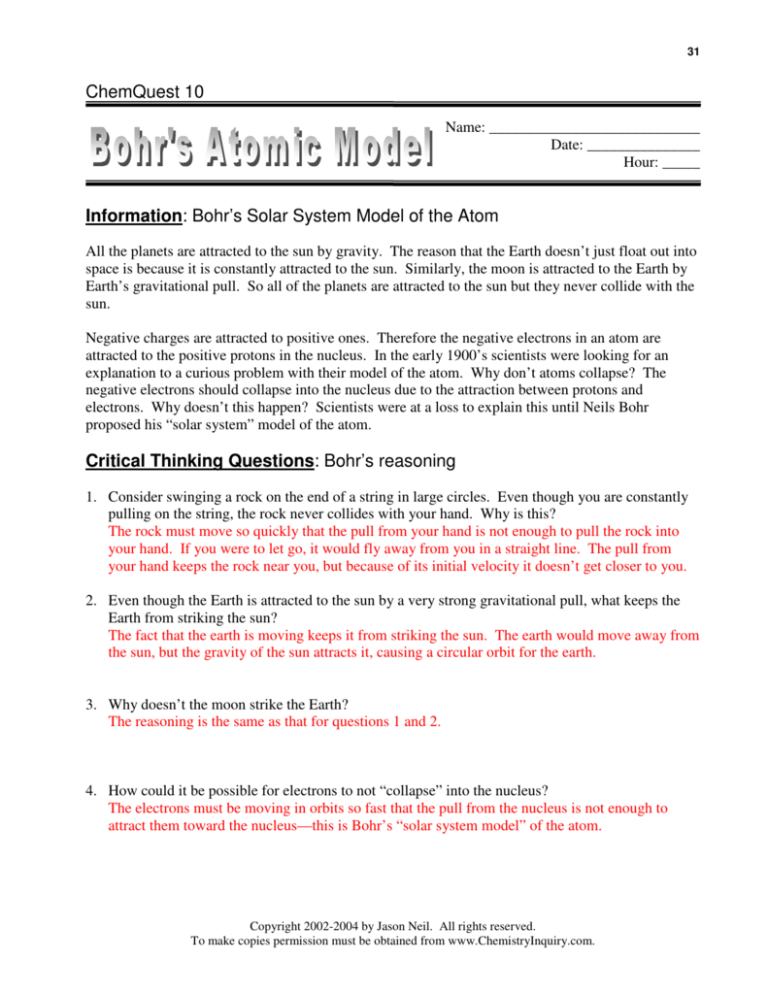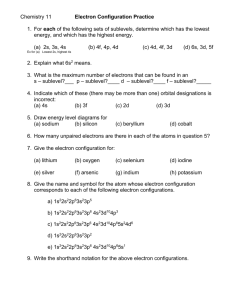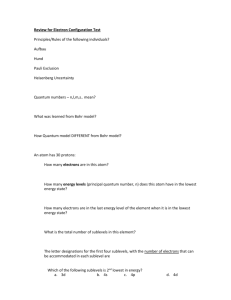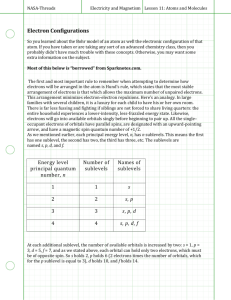
31
ChemQuest 10
Name: ____________________________
Date: _______________
Hour: _____
Information: Bohr’s Solar System Model of the Atom
All the planets are attracted to the sun by gravity. The reason that the Earth doesn’t just float out into
space is because it is constantly attracted to the sun. Similarly, the moon is attracted to the Earth by
Earth’s gravitational pull. So all of the planets are attracted to the sun but they never collide with the
sun.
Negative charges are attracted to positive ones. Therefore the negative electrons in an atom are
attracted to the positive protons in the nucleus. In the early 1900’s scientists were looking for an
explanation to a curious problem with their model of the atom. Why don’t atoms collapse? The
negative electrons should collapse into the nucleus due to the attraction between protons and
electrons. Why doesn’t this happen? Scientists were at a loss to explain this until Neils Bohr
proposed his “solar system” model of the atom.
Critical Thinking Questions: Bohr’s reasoning
1. Consider swinging a rock on the end of a string in large circles. Even though you are constantly
pulling on the string, the rock never collides with your hand. Why is this?
The rock must move so quickly that the pull from your hand is not enough to pull the rock into
your hand. If you were to let go, it would fly away from you in a straight line. The pull from
your hand keeps the rock near you, but because of its initial velocity it doesn’t get closer to you.
2. Even though the Earth is attracted to the sun by a very strong gravitational pull, what keeps the
Earth from striking the sun?
The fact that the earth is moving keeps it from striking the sun. The earth would move away from
the sun, but the gravity of the sun attracts it, causing a circular orbit for the earth.
3. Why doesn’t the moon strike the Earth?
The reasoning is the same as that for questions 1 and 2.
4. How could it be possible for electrons to not “collapse” into the nucleus?
The electrons must be moving in orbits so fast that the pull from the nucleus is not enough to
attract them toward the nucleus—this is Bohr’s “solar system model” of the atom.
Copyright 2002-2004 by Jason Neil. All rights reserved.
To make copies permission must be obtained from www.ChemistryInquiry.com.
32
Information: Light
Recall that light is a wave. White light is composed of all the colors of light in the rainbow. All light
travels at the same speed (c), 3.00 x 108 m/s. (The speed of all light in a vacuum is always equal to
3.0 x 108 m/s.) Different colors of light have different frequencies (f) and wavelengths (λ). The
speed (c), frequency (f) and wavelength (λ) of light can be related by the following equation:
c=f •λ
It is important that the wavelength is always in meters (m), the speed is in m/s and the frequency is in
hertz (Hz). Note: 1 Hz is the inverse of a second so that 1 Hz = 1/s.
Critical Thinking Questions
5. As the frequency of light increases, what happens to the wavelength of the light?
As the frequency increases, the wavelength must be smaller. This is because the frequency times
the wavelength must always equal 3.00x108 m/s.
6. What is the frequency of light that has a wavelength of 4.25 x 10-8 m?
3.00 x10 8 m / s
c = f •λ → f = =
= 7.06 x1015 Hz
−8
λ
4.25 x10 m
7. What is the wavelength of light that has a frequency of 3.85 x 1014 Hz?
c 3.00 x108 m / s
c = f •λ → λ = =
= 7.79 x10 −7 m
14
f
3.85 x10 Hz
c
Information: Energy levels
After Bohr proposed the Solar System Model (that electrons orbit a nucleus just like planets orbit the
sun), he called the orbits “energy levels”.
Consider the following Bohr model of a Boron atom:
= proton (positive charge)
= electron (negative charge)
= neutron (no charge)
1st
energy
level
2nd
energy
level
Higher energy levels are further from the nucleus. For an electron to go into a higher energy level it
must gain more energy. Sometimes the electrons can absorb light energy. (Recall that different
colors of light have different frequencies and wavelengths.) If the right color (and therefore,
frequency) of light is absorbed, then the electron gets enough energy to go to a higher energy level.
The amount of energy (E) and the frequency (f) of light required are related by the following
equation:
E=h•f
E is the energy measured in Joules (J), f is the frequency measured in Hz, and h is Planck’s constant
in units of J/Hz which is the same as J-second. Planck’s constant, h, always has a value of
6.63x10-34J-s.
33
An electron that absorbs energy and goes to a higher energy level is said to be “excited.” If an
excited electron loses energy, it will give off light energy. The frequency and color of light depends
on how much energy is released. Again, the frequency and energy are related by the above equation.
When an excited electron loses energy, we say that it returns to its “ground state”. Since not all
electrons start out in the first energy level, the first energy level isn’t always an electron’s ground
state.
Critical Thinking Questions
8. Does an electron need to absorb energy or give off energy to go from the 2nd to the 1st energy
level?
It needs to give off energy to go to a lower energy level.
9. How is it possible for an electron go from the 3rd to the 4th energy level?
The electron must absorb energy to go to a higher energy level.
10. Red light of frequency 4.37 x 1014 Hz is required to excite a certain electron. What energy did the
electron gain from the light?
E = h • f = (6.63 x10 −34 )(4.37 x1014 ) = 2.90 x10 −19 J
11. The energy difference between the 1st and 2nd energy levels in a certain atom is 5.01 x 10-19 J.
What frequency of light is necessary to excite an electron in the 1st energy level?
E 5.01x10−19
E = h• f → f = =
= 7.56 x1014 Hz
−34
h 6.63x10
12. a) What is the frequency of light given off by an electron that loses 4.05 x 10-19 J of energy as it
moves from the 2nd to the 1st energy level?
E 4.05 x10 −19
E = h• f → f = =
= 6.11x1014 Hz
− 34
h 6.63x10
b) What wavelength of light does this correspond to (hint: use c = f λ)?
c 3.00 x10 8 m / s
c = f •λ → λ = =
= 4.91x10 −7 m
14
f
6.11x10 Hz
13. Do atoms of different elements have different numbers of electrons?
Yes, atoms of different elements have different numbers of electrons, just as they have
different numbers of protons.
14. If all of the electrons in atom “A” get excited and then lose their energy and return to the ground
state the electrons will let off a combination of frequencies and colors of light. Each frequency
and color corresponds to a specific electron making a transition from an excited state to the
ground state. Consider an atom from element “B”. Would you expect the excited electrons to let
off the exact same color of light as atom “A”? Why or why not?
A different color would be let off because atom B and atom A have different numbers of
electrons. Therefore, we would expect at least a slight difference in colors that are let off.
Copyright 2002-2004 by Jason Neil. All rights reserved.
To make copies permission must be obtained from www.ChemistryInquiry.com.
34
ChemQuest 11
Name: ____________________________
Date: _______________
Hour: _____
Information: Energy Levels and Sublevels
As you know, in his solar system model Bohr proposed that electrons are located in energy
levels. The current model of the atom isn’t as simple as that, however.
Sublevels are located inside energy levels just like subdivisions are located inside cities.
Each sublevel is given a name. Note the following table:
TABLE 1
Energy Level
1st energy level
2nd energy level
3rd energy level
4th energy level
Names of sublevels that exist in the energy level
s
s and p
s, p, and d
s, p, d, and f
Note that there is no such thing as a “d sublevel” inside of the 2nd energy level because there are only
s and p sublevels inside of the 2nd energy level.
Critical Thinking Questions
1. How many sublevels exist in the 1st energy level?
One: only the s sublevel exists.
2. How many sublevels exist in the 2nd energy level?
Two: the s and the p sublevels exist.
3. How many sublevels exist in the 3rd energy level?
Three: the s, p, and d sublevels exist.
4. How many sublevels would you expect to exist in the 5th energy level?
The number of sublevels equals the energy level number, so in the 5th energy level we should
expect 5 sublevels to exist.
5. Does the 3f sublevel exist? (Note: the “3” stands for the 3rd energy level.)
No, in the 3rd energy level there are only s, p, and d sublevels. The following sublevels exist
in the 3rd energy level: 3s, 3p, and 3d.
35
Information: Orbitals
So far we have learned that inside energy levels there are different sublevels. Now we will look at
orbitals. Orbitals are located inside sublevels just like streets are located inside subdivisions.
Different sublevels have different numbers of orbitals.
TABLE 2
# of Orbitals
Sublevel
Possible
s
1
p
3
d
5
f
7
Here’s an important fact: only two electrons can fit in each orbital. So, in an s orbital you can have a
maximum of 2 electrons; in a d orbital you can have a maximum of 2 electrons; in any orbital there
can only be two electrons.
Since a d sublevel has 5 orbitals (and each orbital can contain up to two electrons) then a d sublevel
can contain 10 electrons (= 5 x 2). Pay attention to the difference between “sublevel” and “orbital”.
Critical Thinking Questions
6. How many orbitals are there in a p sublevel? 3
7. How many orbitals are there in a d sublevel? 5
8. a) How many total sublevels would be found in the entire 2nd energy level? Two, since the 2nd
energy level has s and p sublevels.
b) How many orbitals would be found in the entire 2nd energy level? 4 orbitals: the 2s
sublevel has 1 orbital and the 2p sublevel has 3 orbitals for a total of 4 orbitals.
9. a) How many electrons can fit in an f sublevel?
(2 electrons per orbital) x (7 orbitals in an f sublevel) = 14 electrons
b) How many electrons can fit in an f orbital?
Any orbital can only hold 2 electrons.
10. How many electrons can fit in a d orbital? in a p orbital? in any kind of orbital?
Each orbital can hold a maximum of 2 electrons.
11. In your own words, what is the difference between a sublevel and an orbital?
Orbitals are contained within sublevels. A sublevel is a grouping of orbitals.
12. How many electrons can fit in each of the following energy levels:
1st energy level = 2 because only 2 can fit in an s sublevel and the first energy
level only has an s sublevel.
2nd energy level = 8; 2 in the 2s sublevel and 6 in the 2p sublevel giving a total
of 8.
3rd energy level = 18; 2 in the 3s sublevel, 6 in the 3p sublevel, and 10 in the
3d sublevel giving a total of 18.
4th energy level = 32; 2 in the 4f, 6 in the 4p, 10 in the 4d, and 14 in the 4f.
Copyright 2002-2004 by Jason Neil. All rights reserved.
To make copies permission must be obtained from www.ChemistryInquiry.com.
36
Information: Representing the Most Probable Location of an Electron
The following is an “address” for an electron—a sort of shorthand notation. The diagram below
represents an electron located in an orbital inside of the p sublevel in the 3rd energy level.
EXAMPLE #1:
Some important facts about the above diagram:
• The arrow represents an electron.
• The upward direction means that the electron is spinning clockwise.
• “3p” means that the electron is in the p sublevel of the 3rd energy level.
• Each blank represents an orbital. Since there are three orbitals in a p sublevel, there are also
three blanks written beside the p.
• In the diagram, the electron is in the first of the three p orbitals.
Here’s another example:
EXAMPLE #2:
Critical Thinking Questions
13. In example #2, why are there 5 lines drawn next to the d?
In a d sublevel there are 5 orbitals and therefore there needs to be 5 lines drawn.
14. In example #2, what does it mean to have the arrow pointing down?
A downward arrow indicates that the electron is spinning counterclockwise.
15. Write the notation for an electron in a 2s orbital spinning clockwise.
16. Write the notation for an electron in the first energy level spinning clockwise.
Note: in the first energy level, the only sublevel is a 1s.
17. What is wrong with the following notation? You should find two things wrong.
There is no such thing as a d sublevel in the 2nd energy level. Also, a d sublevel needs to have
5 lines drawn for the 5 orbitals in the d sublevel.
18. Write the notation for an electron in the 4th energy level in an f sublevel spinning clockwise.
Skill Practice 10
Name: ______________________________
Date: _______________
Hour: _____
1. Define the terms “ground state” and “excited state”.
Ground state: the normal energy level that an electron occupies.
Excited state: when an electron has absorbed energy to occupy a higher energy level.
2. What is the wavelength of light that has a frequency of 4.22 x 1015 Hz?
7.11x10-8 m
3. What is the energy of light that has a frequency of 1.30 x 1014 Hz?
8.62x10-20 J
4. A certain atom has a green spectrum line of about 540 nm. What is the difference in energy
between the two energy levels responsible for producing the line?
3.68x10-19 J
5. The wavelength of a certain beam of light was 3.52x10-7m.
a) Find the frequency of this light.
8.52x1014 Hz
b) Calculate how much energy this light has.
5.65x10-19 J
6. What is the frequency and wavelength of light that has energy of 5.09 x 10-19 J?
f = 7.68x1014 Hz
λ = 3.91x10-7 m
© 2004 by Jason Neil. All rights reserved.
Skill Practice 11
Name: ______________________________
Date: _______________
Hour: _____
1. What is wrong with the following notation?
There is no such thing as an f sublevel in the third energy level. Also, an f sublevel if it
existed would have five orbitals instead of four.
2. How many sublevels would you expect in the 8th energy level?
8
3. What is the maximum number of electrons that can fit in the 3d sublevel?
10
4. How many electrons can fit in a 2p orbital?
2
5. In the 5th energy level, there is a fifth sublevel called the “g sublevel”. Considering the trend
in number of orbitals and electrons in the s, p, d, and f sublevels, predict how many orbitals
and how many electrons can fit in a g sublevel.
Orbitals = 9
Electrons = 18
6. Considering your answer to question 5, how many electrons can fit in the entire 5th energy
level?
50
7. Write the notation for an electron spinning clockwise in a p sublevel in the 4th energy level.
© 2004 by Jason Neil. All rights reserved.









